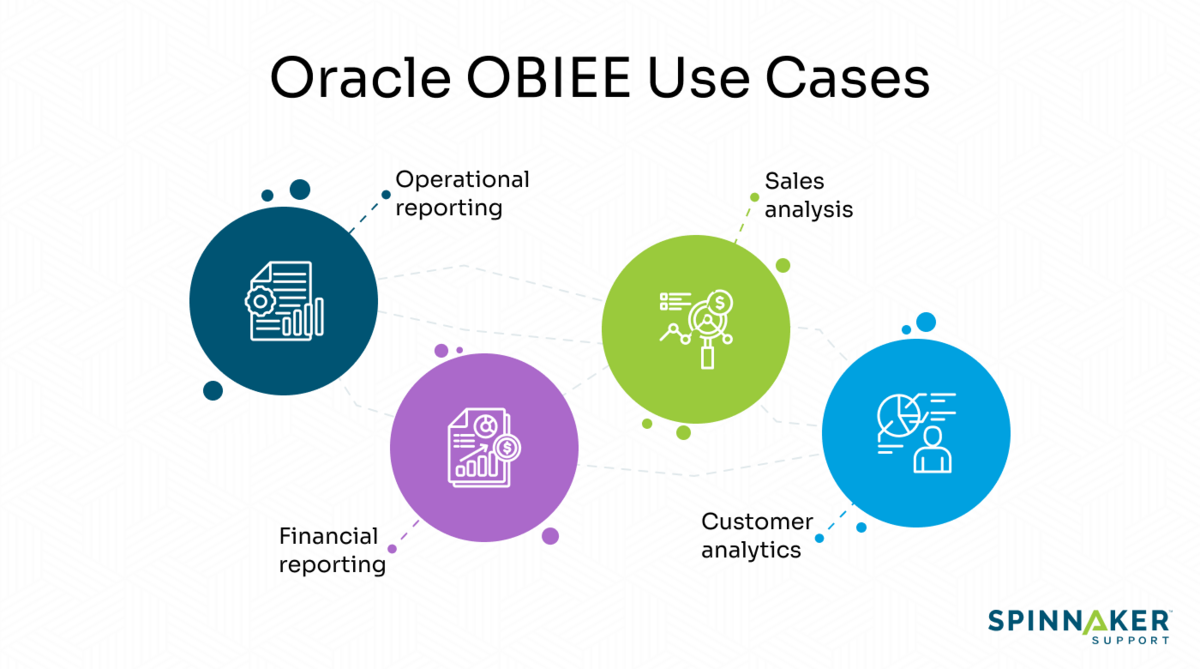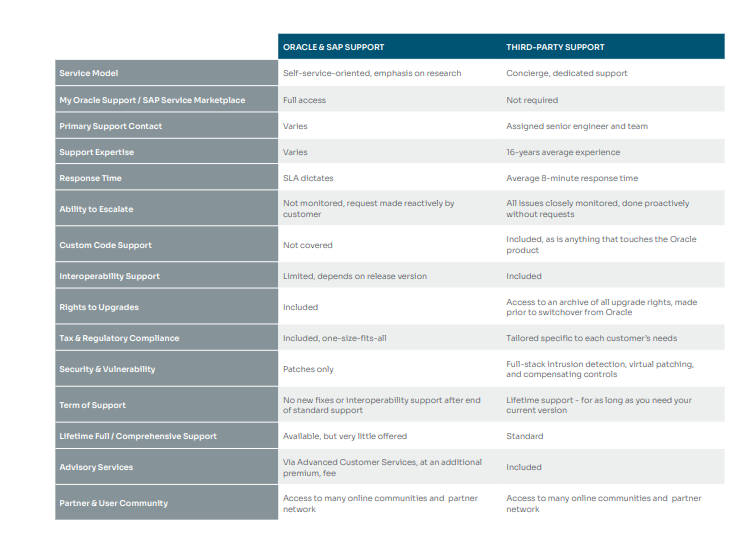Businesses rely on Oracle OBIEE because of its powerful business intelligence (BI) tools. However, Premier Support for OBIEE 12.2.1.4 will end in December 2025, making it harder for businesses to keep their BI environments up to date.
Oracle will no longer provide security patches, updates, or new features for systems that have reached the end of official support. So, if you’re not prepared to migrate, what other support options do you have?
In this article we expound more on Oracle OBIEE, what it is, its use cases, and how to maneuver the end of support from Oracle.
What is Oracle OBIEE?
Oracle Business Intelligence Enterprise Edition (OBIEE) is an all-inclusive set of BI tools that can analyze and display data in different ways. It has many tools that make it easy to create dashboards, generate reports, and analyze data.
OBIEE is built upon BI solutions originally created by Hyperion Systems and Siebel Systems, both of which were acquired by Oracle in 2007 and 2005, respectively. Oracle later changed the name of Siebel Analytics to OBIEE.
Some of the key features of Oracle OBIEE include:
- Alerts and notifications
- Interactive dashboards
- Enterprise reporting
- Actionable Intelligence
- Microsoft Office integration
Your IT department can use OBIEE to make a single, logical view of all enterprise data, whether it’s in a single data warehouse or spread out among many operational and analytical sources.
Although Oracle BI Enterprise Edition (OBIEE) is most often used with Oracle E-Business Suite (EBS), it is capable of collecting and analyzing data from other sources as well.
With OBIEE, you get to have a common reporting framework to build and distribute standardized reports, scorecards, and dashboards.
Importance of Oracle OBIEE
Oracle OBIEE does come with several benefits. Let’s take a look.
Comprehensive BI suite
OBIEE is an all-inclusive business intelligence suite that gives you a full suite of tools for data management, analytics, and reporting.
Some of the key BI capabilities include enterprise and financial reporting, proactive intelligence and alerts, ad hoc analysis, and interactive dashboards.
Because of its extensive capabilities, OBIEE is an indispensable tool if you want to improve your data-driven decision-making techniques.
Robust data visualization capabilities
Thanks to OBIEE’s powerful data visualization features, you can convert complicated data into visual formats that are both intuitive and easy to understand.
You can browse your data for trends, patterns, and outliers with the platform’s extensive collection of interactive graphs, charts, and dashboards.
Data visualization is especially beneficial for non-technical users, as it enables them to investigate and interpret data without needing advanced analytical skills.
OBIEE helps you generate insights by providing visually appealing and customizable dashboards, to help stakeholders quickly understand critical information.
Scalability and performance
OBIEE supports massive data sets and guarantees top-notch performance regardless of the complexity of the data or the number of users.
OBIEE is capable of providing exceptional performance in terms of data processing and query response times due to its advanced caching and in-memory processing capabilities.
If you are in a growing company or if you deal with fluctuating data loads, this scalability ensures timely and accurate data processing without affecting system performance.
Robust security features
Oracle OBIEE provides strong security measures to safeguard sensitive information, an essential concern for any BI platform.
OBIEE’s robust security features, like audit trails, data encryption, and role-based access control, guarantee the protection of sensitive information and proper control of access.
Thus, with these security measures, you can easily protect your data assets and meet regulatory requirements.
Common use cases for Oracle OBIEE
More and more businesses are incorporating BI capabilities into their existing processes, which is driving the adoption of software such as Oracle OBIEE. As of 2023, about 61% of global companies have adopted big data and analytics. So what are the common use cases of this product?

Operational reporting
Oracle OBIEE is a popular tool for operational reporting, which allows you to track and enhance your regular business processes. Using OBIEE, the real-time access to operational data helps you monitor KPIs, assess operational efficiency, and pinpoint improvement opportunities.
This feature is especially helpful in sectors where accurate and detailed reporting is essential to the efficient running of operations, including retail, logistics, and manufacturing. For instance, with OBIEE’s detailed reports, you can make data-driven decisions that improve operational effectiveness on production metrics, inventory levels, supply chain performance, and more.
Financial reporting
OBIEE can help you manage your financial data with accuracy and transparency. With OBIEE, your finance teams can ensure consistent and accurate reporting by consolidating financial information from various sources.
The platform lets you do complex financial analysis, like budgeting, variance analysis, and forecasting, which are all important for financial management.
Therefore with OBIEE’s dashboards and reports you can easily keep tabs on revenue, expenses, profitability, and other important financial metrics. This data is useful for making informed financial decisions and staying compliant with different data regulations.
Sales analysis
In sales analysis, Oracle OBIEE is vital because it gives your sales teams the resources they need to understand and improve their sales performance. Your sales managers can use OBIEE to monitor important measurements like customer acquisition costs, conversion rates, and sales growth.
This helps them to make smart decisions regarding promotions, pricing, and resource allocation. When your sales teams have access to comprehensive reports and forecasts, they are better able to establish attainable goals and meet their revenue goals.
Customer analytics
Oracle OBIEE also has a significant role in customer analytics, which helps you better understand your customers’ habits and preferences.
You can improve customer satisfaction and loyalty by spotting trends in customer data, dividing your customer base into groups, and tailoring your marketing to each group.
OBIEE’s powerful analytical features enable you to monitor customer interactions across various touchpoints. Additionally, OBIEE supports predictive analytics, helping you anticipate customer needs and resolve issues, boosting customer retention and growth.
Limitations of Oracle OBIEE
Although Oracle OBIEE has several benefits, there are also some limitations that come with it. Here are some of them:
Siloed BI deployments across departments
Data silos can form when you don’t integrate business intelligence deployments properly across all of your organization’s applications and departments.
Although OBIEE offers a strong foundation for combining data from various sources, it can become fragmented due to different departmental requirements and standalone implementations.
Lack of standardization and inconsistent data practices often arise when different departments modify their BI solutions independently. Because of this, your company might have trouble developing a unified data strategy, which would hinder collaboration and lessen the impact of its BI initiatives.
Fragmented data
Discrepancies in reports and analyses can occur when data isn’t standardized and integrated consistently throughout the organization.
Because insights are limited to separate data sets instead of a holistic perspective, fragmented information can also make it difficult to acquire a complete understanding of company performance.
To overcome this limitation and make the most of BI initiatives, it is crucial to align OBIEE deployments with a unified data strategy and establish strong data governance practices.
Lack of clear and complete visibility into business performance
Properly configuring and maintaining your Oracle OBIEE is essential to ensure it consistently delivers comprehensive visibility into your business performance.
Inconsistent data quality, incomplete data integration, and complex data models can make it hard to get key insights into different business operations.
In order to make the most of OBIEE, you need a data management strategy and a dedication to keep your data accurate. Otherwise, you risk not having enough visibility and missing out on opportunities to optimize your business performance.
Bypassing Oracle OBIEE end-of-support
Most businesses today place a premium on data and analytics because of the valuable insights they provide, that drive decision-making and boost operational efficiency.
For that reason, to make the most of your data, you need reliable support options that let you customize your BI solutions as you see fit.

Typically, Oracle offers support for at least five years after the release date, with the option to purchase extra extended support for a fee.
Once an OBIEE version hits its end of support life, Oracle stops providing technical support, including security patches and bug fixes, for that version. To take advantage of all the new features and security patches, you are required to upgrade to newer versions.
Premier Support for OBIEE 11g ended at the end of 2018, and Premier Support for OBIEE 12c will end in 2025.
You can divide Oracle’s OBIEE support into three distinct time frames.
- Premier Support: You get maintenance and support for OBIEE from the date of general availability until expiration.
- Extended Support: Oracle offers this option on certain products for an extra fee, but it’s not available for all products or versions.
- Sustaining Support: This option is accessible following the termination of Premier and (paid) Extended Support.
In order to ensure continued support and access to modern features, Oracle recommends that you migrate or upgrade to newer versions of Oracle Analytics Server/Cloud (OAS, OAC).
You can select from one of these three options:
- Oracle Analytics Cloud (OAC),
- Oracle Analytics Server (OAS), or
- Obtain a data analytics solution that is not Oracle-based.
Furthermore, Extended Support is required for customers who want to keep getting error correction for the versions mentioned above after the End of Error corruption date.
Depending on their version of Fusion Middleware, the majority of OBIEE 12c users are no longer supported by Oracle, and the Error Correction Support (ECS) deadlines for OBIEE 11g users have long since passed.
The 12.2.1.3 version of Fusion Middleware has been out of Oracle’s ECS since December 2021.
Get support from a third-party provider
Third-party providers typically offer competitive pricing and different service tiers, so your organization can choose the support level that suits your budget.
This is especially helpful if you wish to prolong the life of your current systems without spending more on migrations or upgrades from vendors.

Hiring a third-party support provider may be more cost-effective rather than upgrading to a newer version of OBIEE or switching to a different business intelligence platform. Third-party providers can create individualized support plans that fit your company’s needs—and they’re usually cheaper than a complete migration or upgrade.
Here’s a rundown of the differences between vendor and third-party support.

As mentioned above, third-party maintenance providers tend to offer more cost-effective support options compared to Oracle’s extended support costs.
After the official end-of-support date has passed, third-party providers can continue to provide patches, fixes, and updates for OBIEE, keeping the environment secure and operational. For instance, Spinnaker has specialized expertise in legacy Oracle systems, including OBIEE.
Even beyond Oracle’s official support timeline, third-party providers like Spinnaker Support often have extensive expertise in maintaining and optimizing Oracle products. They can help you overcome technical obstacles, ensure your systems are stable and functional, and perform any necessary updates.
In addition to standard support, third-party providers often offer extra services like performance tuning, customizations and integrations with other business applications, and security checkups.
When Oracle OBIEE’s official support lifecycle is coming to a close, it is a good idea to consider using third-party providers for support. This way, you can ensure that they have access to technical assistance and expert advice even after the vendor support option has ended.
Conclusion
Customers typically report higher satisfaction levels when they receive support from a third party because of the individualized and adaptable services that these providers provide.
Instead of taking a cookie-cutter approach like vendor support, third-party providers can tailor their support plans to match each client’s unique requirements.
With this individualized approach, you are guaranteed to receive the precise level of support you require, whether for system optimization, maintenance, or troubleshooting.
If you still want to maintain your current BI solution, you can partner with third-party support providers like Spinnaker Support. That way, your software decisions won’t be dictated by the roadmap of your enterprise software provider but by your business initiatives. Reach out to one of our experts to learn more.

